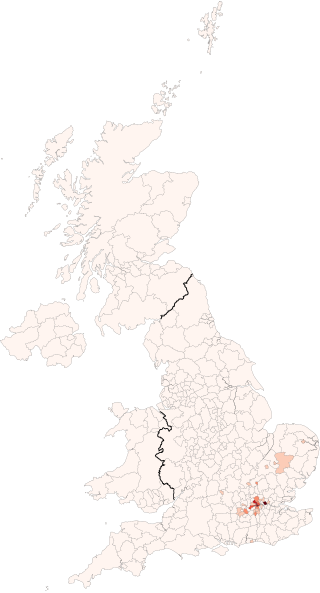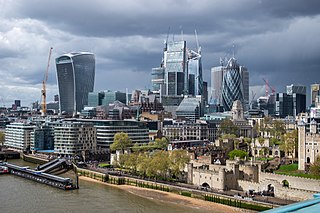Related Research Articles

The term "British subject" has several different meanings depending on the time period. Before 1949, it referred to almost all subjects of the British Empire. Between 1949 and 1983, the term was synonymous with Commonwealth citizen. Currently, it refers to people possessing a class of British nationality largely granted under limited circumstances to those connected with Ireland or British India born before 1949. Individuals with this nationality are British nationals and Commonwealth citizens, but not British citizens.
Since 1945, immigration to the United Kingdom, controlled by British immigration law and to an extent by British nationality law, has been significant, in particular from the Republic of Ireland and from the former British Empire, especially India, Bangladesh, Pakistan, the Caribbean, South Africa, Nigeria, Ghana, Kenya, and Hong Kong. Since the accession of the UK to the European Communities in the 1970s and the creation of the EU in the early 1990s, immigrants relocated from member states of the European Union, exercising one of the European Union's Four Freedoms. In 2021, since Brexit came into effect, previous EU citizenship's right to newly move to and reside in the UK on a permanent basis does not apply anymore. A smaller number have come as asylum seekers seeking protection as refugees under the United Nations 1951 Refugee Convention.

A British Overseas citizen (BOC) is a holder of a residual class of British nationality, largely held by people connected with former British colonies who do not have close ties to the United Kingdom or its remaining overseas territories. Individuals with this form of nationality are British nationals and Commonwealth citizens, but not British citizens. BOCs are subject to immigration control when entering the United Kingdom and do not have the automatic right of abode there or in any British overseas territory.

A UK Ancestry visa is a visa issued by the United Kingdom to Commonwealth citizens with a grandparent born in the United Kingdom, Channel Islands, Isle of Man or Ireland who wish to work in the United Kingdom. It is used mainly by young Canadians, Australians, New Zealanders and South Africans of British descent coming to the UK to work and as a base to explore Europe.
A Commonwealth citizen is a citizen or qualified national of a Commonwealth of Nations member state. Most member countries do not treat citizens of other Commonwealth states any differently from foreign nationals, but some grant limited citizenship rights to resident Commonwealth citizens. In 16 member states, resident non-local Commonwealth citizens are eligible to vote in elections. The status is most significant in the United Kingdom, and carries few or no privileges in many other Commonwealth countries.

A British Overseas Territories citizen (BOTC), formerly called British Dependent Territories citizen (BDTC), is a member of a class of British nationality granted to people connected with one or more of the British Overseas Territories.
Somalis in the United Kingdom include British citizens and residents born in or with ancestors from Somalia. The United Kingdom (UK) is home to the largest Somali community in Europe, with an estimated 108,000 Somali-born immigrants residing in the UK in 2018 according to the Office for National Statistics. The majority of these live in England, with the largest number found in London. Smaller Somali communities exist in Birmingham, Bristol, Manchester, Liverpool, Leicester, Milton Keynes, Sheffield and Cardiff.
Ghanaians in the United Kingdom encompass both Ghana-born immigrants and their descendants living in the United Kingdom. Immigration to the UK accelerated following the independence of Ghana from the British Empire in 1957, with most British Ghanaians having migrated to the UK between the 1960s to the 1980s owing to poor economic conditions at home.
British Nigerians have formed long-established communities in London, Liverpool and other industrial cities. Many Nigerians and their British-born descendants in Britain live in South London, and they are one of the larger immigrant groups in the country.

Filipinos in the United Kingdom are British citizens or immigrants who are of Filipino ancestry.
British Jamaicans are British people who were born in Jamaica or who are of Jamaican descent. The community is well into its third generation and consists of around 300,000 individuals, the second-largest Jamaican population, behind the United States, living outside of Jamaica. The majority of British people of Jamaican origin were born in the United Kingdom as opposed to Jamaica itself. The Office for National Statistics estimates that in 2015, some 137,000 people born in Jamaica were resident in the UK. The number of Jamaican nationals is estimated to be significantly lower, at 49,000 in 2015.
Latin American migration to the United Kingdom dates back to the early 19th century. However, before the 1970s, when political and civil unrest became rife in many Latin American countries, the United Kingdom's Latin American community was not particularly large. Economic migration to the United Kingdom has since increased. Brazilian and Colombian-born residents are the two largest groups standing at 95,000 and 36,000 respectively as of 2019. A number of refugees and asylum seekers moved to the UK during the late 20th century, however, since the turn of the century, Latin Americans have been migrating to the UK for a wide range of reasons and at present the community consists of people from all walks of life. The UK is also home to British-born people of Latin American ancestry. During the 2008–2014 Spanish financial crisis, Britain also became one of the favourite European destinations for some of the roughly 1.4 million Latin Americans who had acquired Spanish citizenship.
Colombians in the United Kingdom or Colombian Britons include British citizens or residents who are of Colombian ancestry. According to the 2011 UK Census, the Colombian-born population of England was 25,016, Wales 166, Scotland 507 and Northern Ireland 72.
Mexicans in the United Kingdom or Mexican Britons include Mexican-born immigrants to the United Kingdom and their British-born descendants. Although a large percentage of Mexican-born people in the UK are international students, many are also permanently settled and work in the UK as the community expands into its second generation.
Peruvians in the United Kingdom or Peruvian Britons are Peruvian immigrants to the United Kingdom, who form part of the larger Latin American community in the UK. In 2001, the stock of Peruvian-born immigrants was the sixth largest amongst all Latin American immigrants to the UK.
Barbadian British people, Bajan Brits or British Barbadians, are citizens or residents of the United Kingdom whose ethnic origins lie fully or partially in the Caribbean island of Barbados. The UK is home to the second largest Barbadian-born migrant population out of all the OECD countries, with the 2001 Census recording 21,601 UK residents born on the Caribbean island, compared to the 53,785 Barbadian-born residents of the United States.
British Afghans are British citizens and non-citizen residents born in or with ancestors from, Afghanistan, part of worldwide Afghan diaspora. The Office for National Statistics (ONS) estimates that there were 79,000 people born in Afghanistan living in the UK in 2019.
Algerians in the United Kingdom are residents of the UK with ancestry from Algeria. They include Algerian-born immigrants and their British-born descendants.

The Embassy of Ecuador in London is the diplomatic mission of Ecuador in the United Kingdom. It is headed by the ambassador of Ecuador to the United Kingdom. It is located in the Knightsbridge area of London, in the Royal Borough of Kensington and Chelsea. It is in an apartment building which also houses the Embassy of Colombia as well as a number of residential apartments, near Harrods, Hyde Park, and Hans Place, at 3 Hans Crescent at the intersection with Basil Street, and it is close to Knightsbridge Underground station.

Greater London is the administrative area of London, England, coterminous with the London region. It contains 33 local government districts: the 32 London boroughs, which form a ceremonial county also called Greater London, and the City of London. The Greater London Authority is responsible for strategic local government across the region, and regular local government is the responsibility of the borough councils and the City of London Corporation. Greater London is bordered by the ceremonial counties of Hertfordshire to the north, Essex to the north-east, Kent to the south-east, Surrey to the south, and Berkshire and Buckinghamshire to the west.
References
- ↑ "Trends in International Migrant Stock: Migrants by Destination and Origin (United Nations database, POP/DB/MIG/Stock/Rev.2015)". United Nations, Department of Economic and Social Affairs. 2015. Retrieved Jun 24, 2016.
- ↑ "Country-of-birth database". Organisation for Economic Co-operation and Development. Archived from the original on 2009-06-17. Retrieved 2009-01-25.
- ↑ Brown, Jonathan (2006-06-22). "The little corner of London that's forever Ecuador". The Independent. Archived from the original on June 5, 2010. Retrieved 2009-01-10.
- 1 2 3 4 5 James, Malcolm (November 2005). "Ecuadorian identity, community and multi-cultural integration" (PDF). Runnymede Trust . Retrieved 2009-02-25.
- ↑ Sofia Buchuck. "Crossing borders: Latin American exiles in London". untoldLondon. Archived from the original on 2009-04-05. Retrieved 2008-04-12.
- ↑ "Table 1.3: Estimated population resident in the United Kingdom, by foreign country of birth, 60 most common countries of birth, January 2008 to December 2008". Office for National Statistics. Archived from the original on 2011-06-05. Retrieved 2009-11-22.
- ↑ Chilton, Tony; Kilsby, Peter (1999-04-20). "Persons Granted British Citizenship, United Kingdom, 1998" (PDF). Home Office. Archived from the original (PDF) on 2007-07-12. Retrieved 2009-11-22.
- ↑ Kilsby, Peter; McGregor, Rod (2000-06-08). "Persons Granted British Citizenship, United Kingdom, 1999" (PDF). Home Office. Archived from the original (PDF) on 2007-07-12. Retrieved 2009-11-22.
- ↑ Dudley, Jill; Harvey, Paul (2001-05-31). "Persons Granted British Citizenship, United Kingdom, 2000" (PDF). Home Office. Archived from the original (PDF) on 2007-07-12. Retrieved 2009-11-22.
- ↑ Dudley, Jill; Hesketh, Krystina (2002-06-27). "Persons Granted British Citizenship, United Kingdom, 2001" (PDF). Home Office. Archived from the original (PDF) on 2007-07-12. Retrieved 2009-11-22.
- ↑ Dudley, Jill; Woollacott, Simon (2003-08-28). "Persons Granted British Citizenship, United Kingdom, 2002" (PDF). Home Office. Archived from the original (PDF) on 2007-07-12. Retrieved 2009-11-22.
- ↑ Dudley, Jill; Woollacott, Simon (2004-05-24). "Persons Granted British Citizenship, United Kingdom, 2003" (PDF). Home Office. Archived from the original (PDF) on 2009-03-26. Retrieved 2009-11-22.
- ↑ Woollacott, Simon (2005-05-17). "Persons Granted British Citizenship, United Kingdom, 2004" (PDF). Home Office. Archived from the original (PDF) on 2009-03-26. Retrieved 2009-11-22.
- ↑ Freelove Mensah, John (2006-05-23). "Persons Granted British Citizenship, United Kingdom, 2005" (PDF). Home Office. Archived from the original (PDF) on 2009-03-26. Retrieved 2009-11-22.
- ↑ Freelove Mensah, John (2006-05-23). "Persons Granted British Citizenship, United Kingdom, 2006" (PDF). Home Office. Archived from the original (PDF) on 2009-03-24. Retrieved 2009-11-22.
- ↑ Freelove Mensah, John (2008-05-20). "Persons Granted British Citizenship, United Kingdom, 2007" (PDF). Home Office. Archived from the original (PDF) on 2009-11-22. Retrieved 2009-11-22.
- ↑ Freelove Mensah, John (2008-05-20). "Persons Granted British Citizenship, United Kingdom, 2008" (PDF). Home Office. Archived from the original (PDF) on 2009-08-04. Retrieved 2009-11-22.
- 1 2 3 4 5 6 7 8 9 "Asylum Statistics United Kingdom 2001" (PDF). Home Office. Archived from the original (PDF) on 2006-05-04. Retrieved 2009-02-18.
- 1 2 "Asylum Statistics United Kingdom 2003" (PDF). Home Office. Archived from the original (PDF) on 2011-01-18. Retrieved 2010-07-28.
